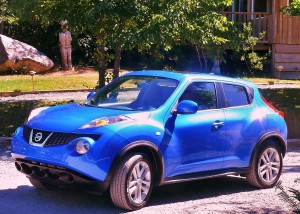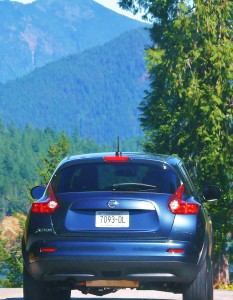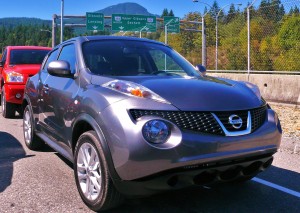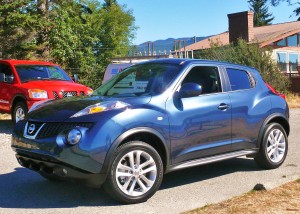Nissan Juke could…go…all…the…way
VANCOUVER, British Columbia — Imagine a wild party being conducted at Nissan’s design studio, where people from every cubicle choose up sides and play “spin the concept” — in which every participant tosses an ingredient from crossover SUVs, sports cars, compact and subcompact designs and features into a blender. Puree the whole thing, then shake well, and pour out a unique vehicle. Allow it to harden, then squash it down to a size small enough to start a new segment.
Call it “sport-crossover-hatchback-runabout.” Nissan calls it the “Juke.”
Football season is a great time to introduce a car with that name. Fans might appreciate the analogy most, because while some prefer watching a skilled passing attack from someone like Brett Favre, others might prefer the running game, the way Adrian Peterson rushes. When the Minnesota Vikings move the ball, Favre simply hands off to Peterson, who runs through the line with force, feinting an instant one way, then darting the other, all in a split second. That ability, which is nearly impossible for opponents to defend, is called a “juke” in football jargon.
Capitalize the NFL’s slang term for such a deceptive move, capitallize it, and the Juke emerges as Nissan’s newest vehicle. — capable of dashing through congested traffic with power, quickness and precision.
The Juke is deceptive in every way, defying traditional segments as easily as it slip through openings in congested traffic. It is not a car, really, nor is it a truck, and it’s not a sports car or crossover, either. Larry Dominique, who oversees Nissan project engineering, calls it “a sport-cross design that combines urban versatility with agile handling and adaptability.”
When it comes to unorthodox, Nissan is preparing to introduce its plug-in electric Leaf, and maybe the Juke is the perfect set-up for the Leaf. The Juke’s styling can generously be termed surprising, and the same goes for its power, which comes with a small 1.6-liter 4-cylinder, with direct injection and turbocharging to make its chain-driven, dual-overhead-camshafts run its dual variable-valve-timed 16 valves through their paces. Those paces run up to 188 horsepower at 5,600 RPMs, and 177 foot-pounds of torque, which hold that peak from 2,000-5,200 RPMs. Either a 6-speed stick shift of Nissan’s Xtronic CVT (continuously variable transmission) is available, as is either front- or all-wheel drive.
Estimated fuel economy is 27 city and 32 highway for the vehicle, which is built on a widened version of the subcompact Versa’s B-platform.Interior room is surprisingly spacious, with 10 cubic feet of storage behind the second row seat, or 35.9 cubic feet if you fold the rear seat down. The Juke measures 162.4 inches long, with a 99.6-inch wheelbase, and a width of 69.5, standing 61.8 inches tall.
Occupants sit up a bit higher than in most small cars, and Nissan is aiming the Juke at the Mazda3, Mini Cooper, Suzuki SX4, and Toyota Matrix and Scion tC. They might also have included the Honda Fit and the new Ford Fiesta hatchback. To take on such worthy competition, the Juke needs a low sticker price and a lot of performance agility, and Nissan made sure the Juke is well-endowed for either. Backing up its power, Juke base prices range from $19,710 to $25,300.
Without question, the Juke is startling when first seen. My first impression of the Juke front end’s wide-set headlights was a cartoon bullfrog. The lower fascia sweeps upward at both ends, and those headlights are plugged into the upper part of the fascia, right about where you might expect foglights to be. A thinner strip of lights runs vertically up and over the top edge of the fenders, and are visible from the interior. There is nothing weird about cartoons, or bullfrogs, by the way, and as many might find the Juke cute as unorthodox, but it is definitely far enough out of the mainstream to create its own channel.
Nissan has produced beautiful vehicles such as the 370 Z sports car, Altima and Maxima sedans, as well as the Infiniti G Coupe and Sedan, and the new M37 and M56 Infinitis. All are strikingly beautiful in design. Nissan also startled us all with the Murano crossover SUV, and the Infiniti FX models, which have been successful, even though their rounded-edge, rolling style falls more into the unusual region — something that must grow on customers. Same with the Rogue, Murano’s hot-selling and inexpensive compact crossover cousin.
Now comes the Juke, a new member to that ever-narrowing line between smaller crossovers and expanding subcompacts, literally crossing over to link both.The just-introduced Juke was voted to the candidate list for 2011 North American Car of the Year, but it might have been just as comfortable as a “mini-truck” of the year, if there was such a category.
Dominique will settle for the small crossover designation. “Small crossovers are expected to grow by 200 percent between 2005 and 2014,” he said, noting we are halfway from zero toward that 200 percent right now.
Typical with Nissan, the true beauty of the Juke comes from inside behind the steering wheel. A high shift lever, located on a circular mound of hard plastic, and other hard plastic surfaces on the dashboard, might lack the currently trendy soft-touch feel, but instruments are reminiscent of a motorcycle to the driver. Nissan says it is aiming the Juke at young males, which is not a surprise. In reality, young women — perhaps more secure in their identities — will readily buy macho-targeted vehicles, while young men might have nothing to do with a vehicle discerned as aimed at women.
Every gender will appreciate the Juke’s performance. Its turbo power zips around and through congested traffic, and it also is fun to drive on the highways. We got to try both. The Juke was introduced to the North American media at the Shangri La Hotel in Vancouver, and we were soon driving off through the city, then across the Lions Gate Bridge and up to catch the Horseshoe Bay Ferry to Langdale. From there, we drove north through some breathtaking scenery to our lunch destination at the West Coast Wilderness Lodge, before heading back toward Langdale and the ferry.
Nissan has been the most dedicated manufacturer to refine CVT automatics, which constantly shift via a belt while feeling as though they are never shifting, and that dedication is good reason the company is the most accomplished at the constantly-shifting system. Paddles allow the driver to squeeze the belt down to varying torque levels on the CVT, almost as effectively as a normal gearbox downshift. Power is distributed to either the front wheels or to all four, in all models.
Running through the base prices, before adding the $750 destination fee, the S model with front-wheel drive and VCVT is $18,960, and the AWD model is $20,460; moving up to the SV adds a moonroof and other features, costing $20,260 for the manual FWD, $20,760 for the FWD with CVT, and $22,600 for the AWD with the CVT; and the SL, which adds leather seats and navigation, starts at $22,550 for the FWD stick, $23,050 for the FWD with CVT, and $24,550 for the AWD with CVT.
At those prices, all Jukes come well equipped. The base model S has 4-wheel disc brakes, keyless entry, cruise control, 17-inch alloy wheels, 60-40 fold-flat rear seat, and speed-sensitive door locks and power-assisted steering, , and offers, and most of the features on the upgraded models, such as heated leather seats, navigation system with 5-inch screen, and iPod and Bluetooth connectivity, are available as options. And there is no “base” engine — all models come with the high-tech, turbo engine.
Comments
One Comment on Nissan Juke could…go…all…the…way
-
sensa weight loss on
Sun, 10th Aug 2014 11:38 am
Hello would you mind sharing which blog platform you’re working with?
I’m going to start my own blog in the near future but I’m
having a hard time making a decision between BlogEngine/Wordpress/B2evolution and Drupal.
The reason I ask is because your design and style seems different then most
blogs and I’m looking for something completely unique.
P.S Apologies for getting off-topic but I had to ask!
>sensa weight loss
(It is a modified WordPress theme…Get onto WodrPress.com, and you’ll find dozens of interesting possibilities. — JG)
Tell me what you're thinking...
and oh, if you want a pic to show with your comment, go get a gravatar!






 John Gilbert is a lifetime Minnesotan and career journalist, specializing in cars and sports during and since spending 30 years at the Minneapolis Tribune, now the Star Tribune. More recently, he has continued translating the high-tech world of autos and sharing his passionate insights as a freelance writer/photographer/broadcaster. A member of the prestigious North American Car and Truck of the Year jury since 1993. John can be heard Monday-Friday from 9-11am on 610 KDAL(www.kdal610.com) on the "John Gilbert Show," and writes a column in the Duluth Reader.
John Gilbert is a lifetime Minnesotan and career journalist, specializing in cars and sports during and since spending 30 years at the Minneapolis Tribune, now the Star Tribune. More recently, he has continued translating the high-tech world of autos and sharing his passionate insights as a freelance writer/photographer/broadcaster. A member of the prestigious North American Car and Truck of the Year jury since 1993. John can be heard Monday-Friday from 9-11am on 610 KDAL(www.kdal610.com) on the "John Gilbert Show," and writes a column in the Duluth Reader.